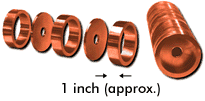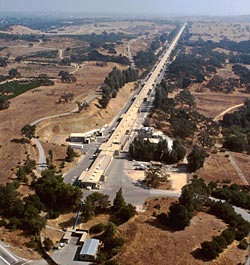Linear accelerators, or linacs for short, have been around for decades and yet are now becoming more common, especially in industry. For instance, radiotherapy machines can be found in hospitals all over the world. The x-ray machine, for example, accelerates particles to energies of 4-30MeV. Lower energy linacs are also used for the sterilization of metals. These are normally a single section of oscillating rf field generating rings connected to a power source. High-energy linacs (50MeV-50GeV) are much larger; their main uses are in labs for various particle physics experiments and are sometimes used as injectors for circular accelerators and storage rings. These contain many sections of oscillating charge rings in sequence to generate very long rf fields and accelerate particles to high energies over great distances.
 The 2-mile SLAC linear accelerator (linac) is made from over 80,000 of these copper discs
and cylinders brazed together.
12
The 2-mile SLAC linear accelerator (linac) is made from over 80,000 of these copper discs
and cylinders brazed together.
12
The largest linear particle accelerator in the world is located at Stanford University in California. Founded in 1962, it was originally known as the Stanford Linear Accelerator Centre (SLAC), but in October of 2008 the name was changed to the SLAC National Accelerator Laboratory. Research at SLAC has given rise to three Nobel prizes, discovery of the charm quark and tau lepton and the quark structure inside protons and neutrons. 22
The main accelerator at SLAC is about 3.2km long and it is buried 10m below the ground. In addition to being the longest accelerator in the world, it has also been called the world's straightest object. It is capable of accelerating electrons and positrons to 50GeV; these two particles are then sent on a collision course so they can be more closely studied. The research at SLAC investigates how matter behaves at both the smallest and largest scales. 23

Aerial view of entire SLAC with diagram overlay 14
|
Did you know?
You probably have a linear accelerator in your own home- and use it
regularly. The last generation of televisions (non-flat-panel) used cathode ray tubes
to accelerate electrons towards a phosphorescent material at different energies to cause it
to emit the colours you see when you're watching your favourite shows!
|
